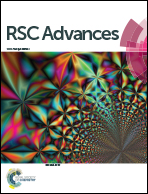Solution processed sun baked electrode material for flexible supercapacitors†
Abstract
We report a new strategy for making electrode materials for supercapacitors based on a nanocrystalline Pd/carbon (nc-Pd/C) composite, obtained by thermolyzing a thin film of Pd hexadecylthiolate under sunlight. Thus obtained nc-Pd/C composite is porous (BET specific surface area, 67 m2 g−1), hydrophilic (contact angle, 49°) and of good electrical conductivity (resistivity ∼ 2 μΩ m), all these properties being highly suitable for supercapacitor electrodes. The autocatalytic nature of the nc-Pd/C composite was exploited for electrolessly depositing MnO2 bearing a nanowall morphology to serve as a pseudocapacitive material. Using MnO2/nc-Pd/C electrodes in 1 M Na2SO4, a specific capacitance of ∼450 F g−1 was obtained at 10 mV s−1. An asymmetric supercapacitor was fabricated by employing MnO2/nc-Pd/C as a positive electrode and nc-Pd/C as a negative electrode, where the potential window could be enhanced to 1.8 V with an energy density of 86 W h kg−1. The electrode precursor being a direct write lithography resist allowed fabrication of a planar micro-supercapacitor with an ionic liquid as electrolyte, exhibiting a cell capacitance of 8 mF cm−2. As our recipe does not make use of an additional charge collecting layer and binder, nor does it use any external energy during fabrication, the only cost consideration is related to Pd; however, given the extremely small amount of Pd consumed per device (∼0.18 mg), it is highly cost effective.


 Please wait while we load your content...
Please wait while we load your content...